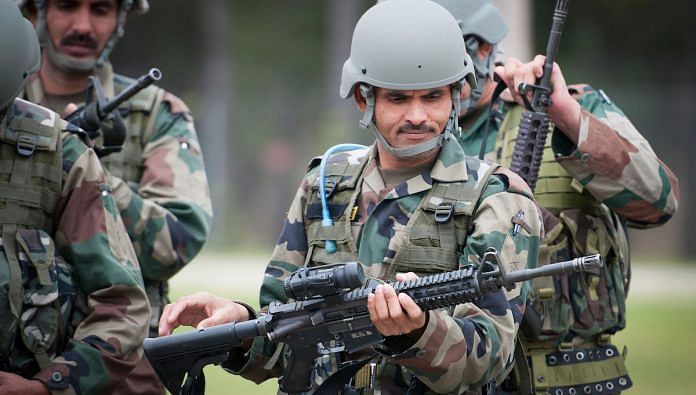There have been multiple attempts to attack India around the anniversary of the 2016 surgical strikes. India shouldn’t hesitate to strike back at Pakistan.
Over the last many years it is an expected phenomenon that when an important international personality, especially from the US, visits New Delhi there is an attempt by Pakistan and its proxies to grab headlines in the media through some spectacular acts of violence. The most important such event one can recall was the high profile visit of then President Bill Clinton on 19 March 2000, which saw the Chittisinghpura carnage in Anantnag district with 36 members of the minority Sikh community being gunned down.
US Defence Secretary James Mattis, a man credited with having withstood the Trump idiosyncrasies and protected the space of the US Military, came calling to New Delhi at a significant time. In the follow up after Prime Minister Narendra Modi’s meetings with President Trump, the US has made some relevant noises against Pakistan and its insincerity with reference to transnational terrorism and the pursuit of peace in Afghanistan. None of that has manifested in any action against Pakistan and that country merrily continues to exercise its strategic independence and pursue its interests including further strengthening its relationship with China.
Perhaps just coincidentally the visit of the US Defence Secretary comes just around the first anniversary of India’s surgical strikes in 2016, which were in response to the Pakistan-sponsored terror attack at the Uri brigade headquarters base six kilometres inside the LoC. The LoC and Kashmir have been rife with attempts at resurgence of violence this week.
Four terrorists appear to have infiltrated through the South Jhelum defensive line in Uri sector with the aim of probably targeting the artillery gun positions near village Kalgai on the Uri – Kaman Post – Muzaffarabad road. The aim appeared to have been a repeat of the Uri attack with a possible intent of sending a message of capability to hit an even more important military asset than just an administrative base. In such situations psychological messaging is usually attempted, but Pakistan probably attempted to bite more than it could chew.
I recall, as a former Commander of the Uri Brigade, that we had sightings of terrorists near Kalgai on more than one occasion even 15 years ago. The Indian Army’s active patrolling and intelligence system is effective as has been proven this time; the sighting of terrorists in army uniforms and a quick response saved the day with the killing of all four terrorists.
However, South Jhelum is getting increasingly more vulnerable. The LoC between Kaman Post (Aman Setu) and Salamabad where the transit facility for the Muzaffarabad bus service exists, is a stretch which was extremely active and very prone to infiltration through the Nineties. The Commander of the Uri Brigade, late Brigadier Sridhar was killed in an IED attack on his vehicle placed probably by infiltrators in the mid-Nineties. However, for the last few years this has been a quiet area compared to the activities in the North Jhelum sector from where routes go directly along the mountainous jungle tracts to Baramula.
It is in North Jhelum that the other operation was almost simultaneously undertaken which resulted in the killing of the notorious Qayoom Najjar of Hizbul Mujahideen at a village called Lachhipura on the north bank. Najjar became well known after his feud with Hurriyat leader SAS Geelani and the targeting of mobile towers two years ago. He apparently had made up with the Hizbul Mujahideen leadership after exfiltration last year.
In a probable act of desperation, Hizbul Mujahideen was trying to infiltrate him from a difficult route over a 12,000 feet high pass when he met his doom down below in Lachhipura. The obvious deduction is that there is a lack of leadership within the Hizbul Mujahideen and Zakir Moosa’s (leader of the al Qaeda sponsored Ghazwat ul-Hind) presence is causing some ripples, hence the desperation to get Qayoom Najjar back. Operation All Out of the Indian security forces has definitely had its impact. Sustaining that through winter will be the key.
There is also a report of an attempted action by a small Border Action Team of the Pakistan Army, which usually combines with a few highly trained terrorists, against one of our deployments in Keran sector. This was expected around the anniversary of the surgical strikes. The BAT action has been beaten back, but more can be expected in some of the remote parts of the LoC where response takes time. Parts of Gurez and Gulmarg sector remain vulnerable to this.
Army Chief General Bipin Rawat’s warning that his troops could execute another surgical strike is a timely one at a time when much of the analytical strategic literature is alluding to the surgical strikes being something which cannot be easily repeated. It is good to see this notion being laid to rest by the Army Chief.
The successful action by Indian Special Forces against the NSCN (K) in the Mon sector of Nagaland also could not have come at a better time. It adds to the required confidence.
A reverse action against a Pakistan post on the LoC will very much be in order without the usual garb of having to target terror launch pads. When we have the fullest evidence of Pakistani troops being involved in operations against our soldiers there needs to be no remorse at striking back.




Yes. I agree with the General’s view. In fact as it appears, it seems we already have credible evidence. It’s the appropriate dt & time that should be be under consideration of the GOI/IA.